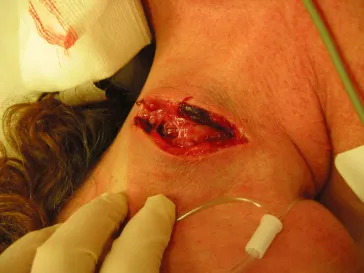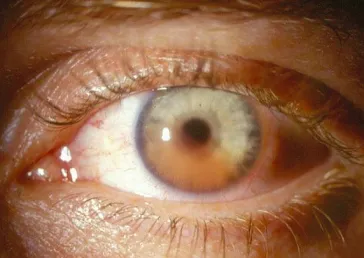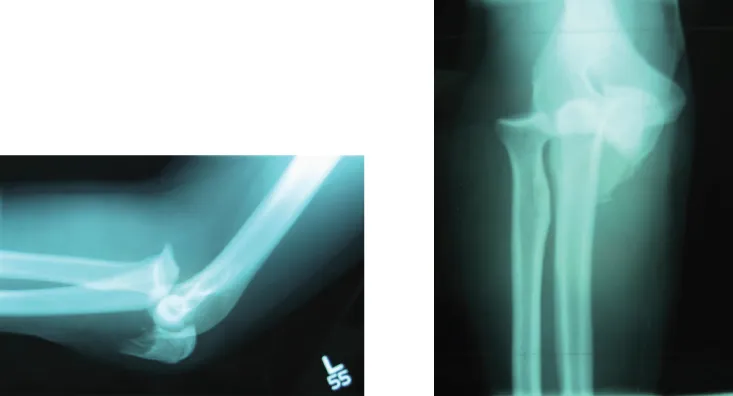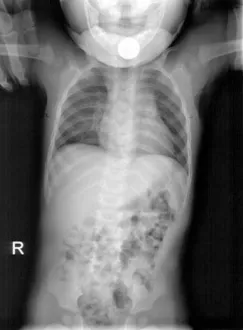![]()
Part I: Case Presentations and Questions
CASE 1
Slash Wound to the Neck
Kevin S. Barlotta, MD and Alexander B. Baer, MD
Case presentation: A 35-year-old female presents to the emergency department after an altercation. She states that she was attacked with a hunting knife. She complains of pain only at the wound site. She denies voice changes or difficulty swallowing. Her injury is depicted in the illustration.
Question: What zone of injury is represented in the image?
A. Zone I
B. Zone II
C. Zone III
D. Zone IV
E. Zone V
See page 77 for Answer, Diagnosis, and Discussion.
![]()
CASE 2
“I’ve Got Blood in My Eye”
Chris S. Bergstrom, MD and Alexander B. Baer, MD
Case presentation: A 22-year-old Caucasian male is evaluated in the emergency department with a complaint of marked left eye pain and blurred vision after being struck in the eye with a lead fishing weight. On physical examination, his visual acuity is 20/60 in the left eye. Pupillary examination is normal. Slit-lamp examination shows a clear cornea. The anterior chamber is deep, with suspended red blood cells in the aqueous humor, as pictured here. The iris detail is slightly obscured but otherwise normal with a central, round pupil.
Question: What is the next best step in this patient’s management?
A. Administration of oral aspirin
B. Infusion of intravenous heparin
C. Emergent lateral canthotomy
D. Administration of oral lisinopril
E. Administration of atropine 1% ophthalmic drops
See page 78 for Answer, Diagnosis, and Discussion.
![]()
CASE 3
Forearm Fracture After Falling
Alexander B. Baer, MD
Case presentation: A 20-year-old male fell on an outstretched upper extremity while snowboarding. He presents with obvious arm deformity. Radiographs of the elbow were obtained.
Question: What is the name of the fracture pictured in the radiographs?
A. Boxer’s fracture
B. Tear drop fracture
C. Tillaux fracture
D. Galeazzi fracture
E. Monteggia fracture
See page 79 for Answer, Diagnosis, and Discussion.
![]()
CASE 4
A Neonate with Fever and Rash
David L. Eldridge, MD
Case presentation: A 10-day-old male is brought to the emergency department by his mother. He has not eaten well for the past 24 hours and has reportedly been “very sleepy.” Yesterday he began to develop a rash that now appears red at the base and is progressively “blistering” with clear fluid on his legs and face (pictured). Tonight he has had two episodes of uncontrollable shaking movements of his arms and legs, each lasting for a “few minutes.” He was born 3 weeks prematurely, and his mother claims no problems or issues with the pregnancy. He is afebrile but appears lethargic on physical examination.
Question: Which of the following tests would be least helpful in the clinical management of this patient given the likely diagnosis in this case?
A. Serologic testing
B. Viral cultures of the conjunctivae, rectum, and nasopharynx
C. Polymerase chain reaction testing of cerebrospinal fluid
D. Liver transaminase levels
E. Viral cultures of the skin lesions
See page 80 for Answer, Diagnosis, and Discussion.
![]()
CASE 5
A Missing Button Battery
Brendan G. Carr, MD and Sarah E. Winters, MD, MSCE
Case presentation: A 2-year-old boy presents to the emergency department with a complaint of food intolerance of abrupt onset. His mom reports that he was seen playing with a small calculator just before lunch. She has subsequently noticed that the calculator is missing its back, and she is concerned that he has swallowed the battery. On examination, he is in no apparent distress and is tolerating his secretions. His vital signs are normal. An X-ray is obtained and is noted here.
Question: What is the next most appropriate management strategy at this time?
A. Discharge home and follow with serial outpatient abdominal X-rays
B. Administer 25 g activated charcoal orally
C. Admit the patient for intravenous hydration, serial abdominal X-rays, and stool checks to confirm passage
D. Infuse 1 mg glucagon intravenous to decrease lower esophageal sphincter pressure and monitor over the following 6 hours
E. Emergent gastroenterology consultation for endoscopic removal of foreign body
See page 80 for Answer, Diagnosis, and Discussion.
![]()
CASE 6
Anorexia, Hair Loss, and Fingernail Bands
Christopher P. Holstege, MD
Case p...






